Research Proposal on Women in Leadership in Higher Education
VerifiedAdded on 2023/06/11
|8
|2038
|94
Report
AI Summary
This research proposal explores the lived experiences of women in educational leadership positions, focusing on their perceptions of the dearth of women in key leadership roles. It delves into the contributions of women in the corporate world, examining their impact on organizations and society, while also considering social norms, beliefs, values, and cultures that have hindered their mobility. The study aims to understand the factors influencing women's success in higher education leadership, including the role of mentorship programs and the support systems needed for career advancement. Research questions address the representation of women in leadership positions, factors motivating or limiting their advancement, and the influence of mentorship programs. The phenomenological research design employs qualitative methods such as interviews and questionnaires to gather in-depth insights from successful women in higher education, with a sample size of fifteen to twenty participants. Secondary data is collected through document analysis of websites, published documents, and reports.
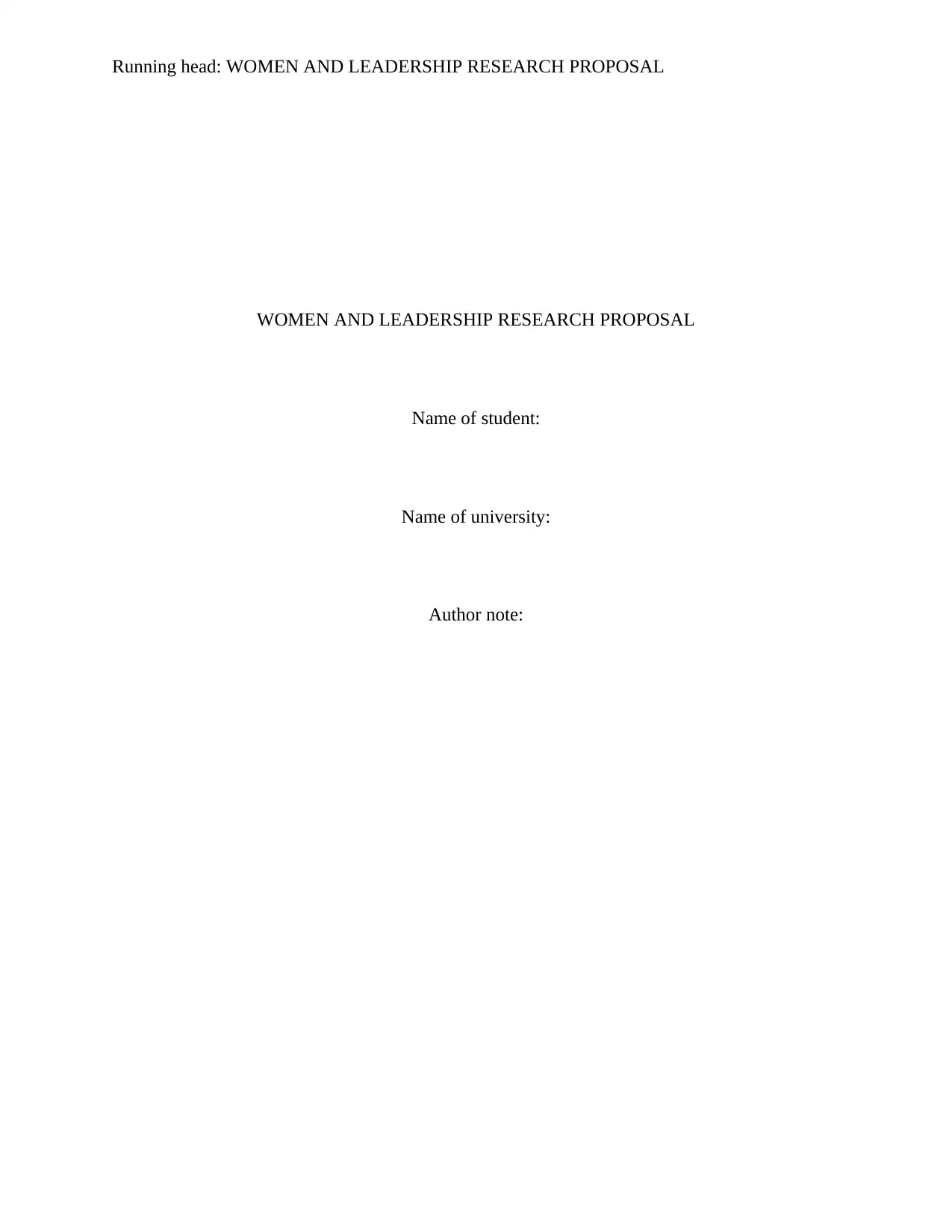
Running head: WOMEN AND LEADERSHIP RESEARCH PROPOSAL
WOMEN AND LEADERSHIP RESEARCH PROPOSAL
Name of student:
Name of university:
Author note:
WOMEN AND LEADERSHIP RESEARCH PROPOSAL
Name of student:
Name of university:
Author note:
Paraphrase This Document
Need a fresh take? Get an instant paraphrase of this document with our AI Paraphraser
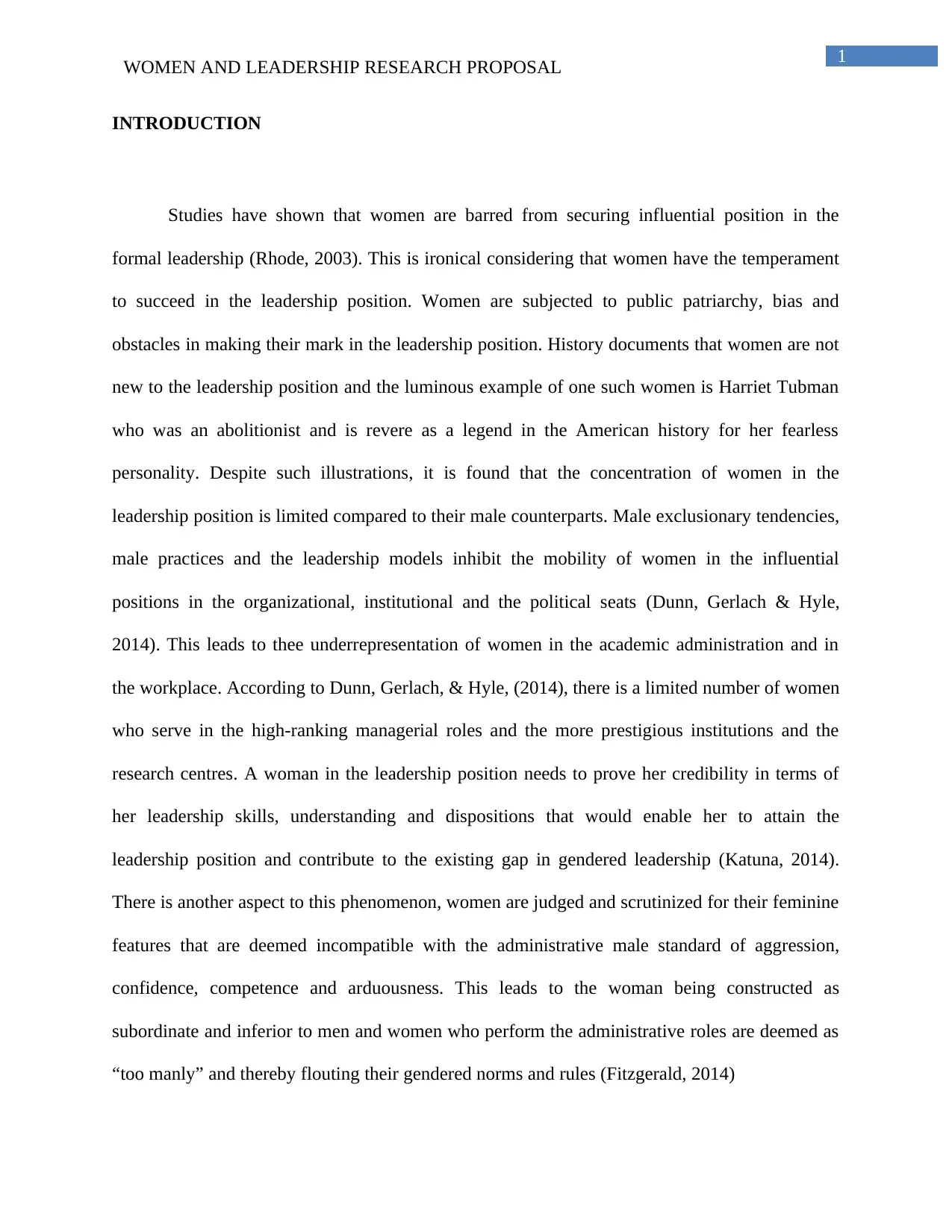
1
WOMEN AND LEADERSHIP RESEARCH PROPOSAL
INTRODUCTION
Studies have shown that women are barred from securing influential position in the
formal leadership (Rhode, 2003). This is ironical considering that women have the temperament
to succeed in the leadership position. Women are subjected to public patriarchy, bias and
obstacles in making their mark in the leadership position. History documents that women are not
new to the leadership position and the luminous example of one such women is Harriet Tubman
who was an abolitionist and is revere as a legend in the American history for her fearless
personality. Despite such illustrations, it is found that the concentration of women in the
leadership position is limited compared to their male counterparts. Male exclusionary tendencies,
male practices and the leadership models inhibit the mobility of women in the influential
positions in the organizational, institutional and the political seats (Dunn, Gerlach & Hyle,
2014). This leads to thee underrepresentation of women in the academic administration and in
the workplace. According to Dunn, Gerlach, & Hyle, (2014), there is a limited number of women
who serve in the high-ranking managerial roles and the more prestigious institutions and the
research centres. A woman in the leadership position needs to prove her credibility in terms of
her leadership skills, understanding and dispositions that would enable her to attain the
leadership position and contribute to the existing gap in gendered leadership (Katuna, 2014).
There is another aspect to this phenomenon, women are judged and scrutinized for their feminine
features that are deemed incompatible with the administrative male standard of aggression,
confidence, competence and arduousness. This leads to the woman being constructed as
subordinate and inferior to men and women who perform the administrative roles are deemed as
“too manly” and thereby flouting their gendered norms and rules (Fitzgerald, 2014)
WOMEN AND LEADERSHIP RESEARCH PROPOSAL
INTRODUCTION
Studies have shown that women are barred from securing influential position in the
formal leadership (Rhode, 2003). This is ironical considering that women have the temperament
to succeed in the leadership position. Women are subjected to public patriarchy, bias and
obstacles in making their mark in the leadership position. History documents that women are not
new to the leadership position and the luminous example of one such women is Harriet Tubman
who was an abolitionist and is revere as a legend in the American history for her fearless
personality. Despite such illustrations, it is found that the concentration of women in the
leadership position is limited compared to their male counterparts. Male exclusionary tendencies,
male practices and the leadership models inhibit the mobility of women in the influential
positions in the organizational, institutional and the political seats (Dunn, Gerlach & Hyle,
2014). This leads to thee underrepresentation of women in the academic administration and in
the workplace. According to Dunn, Gerlach, & Hyle, (2014), there is a limited number of women
who serve in the high-ranking managerial roles and the more prestigious institutions and the
research centres. A woman in the leadership position needs to prove her credibility in terms of
her leadership skills, understanding and dispositions that would enable her to attain the
leadership position and contribute to the existing gap in gendered leadership (Katuna, 2014).
There is another aspect to this phenomenon, women are judged and scrutinized for their feminine
features that are deemed incompatible with the administrative male standard of aggression,
confidence, competence and arduousness. This leads to the woman being constructed as
subordinate and inferior to men and women who perform the administrative roles are deemed as
“too manly” and thereby flouting their gendered norms and rules (Fitzgerald, 2014)
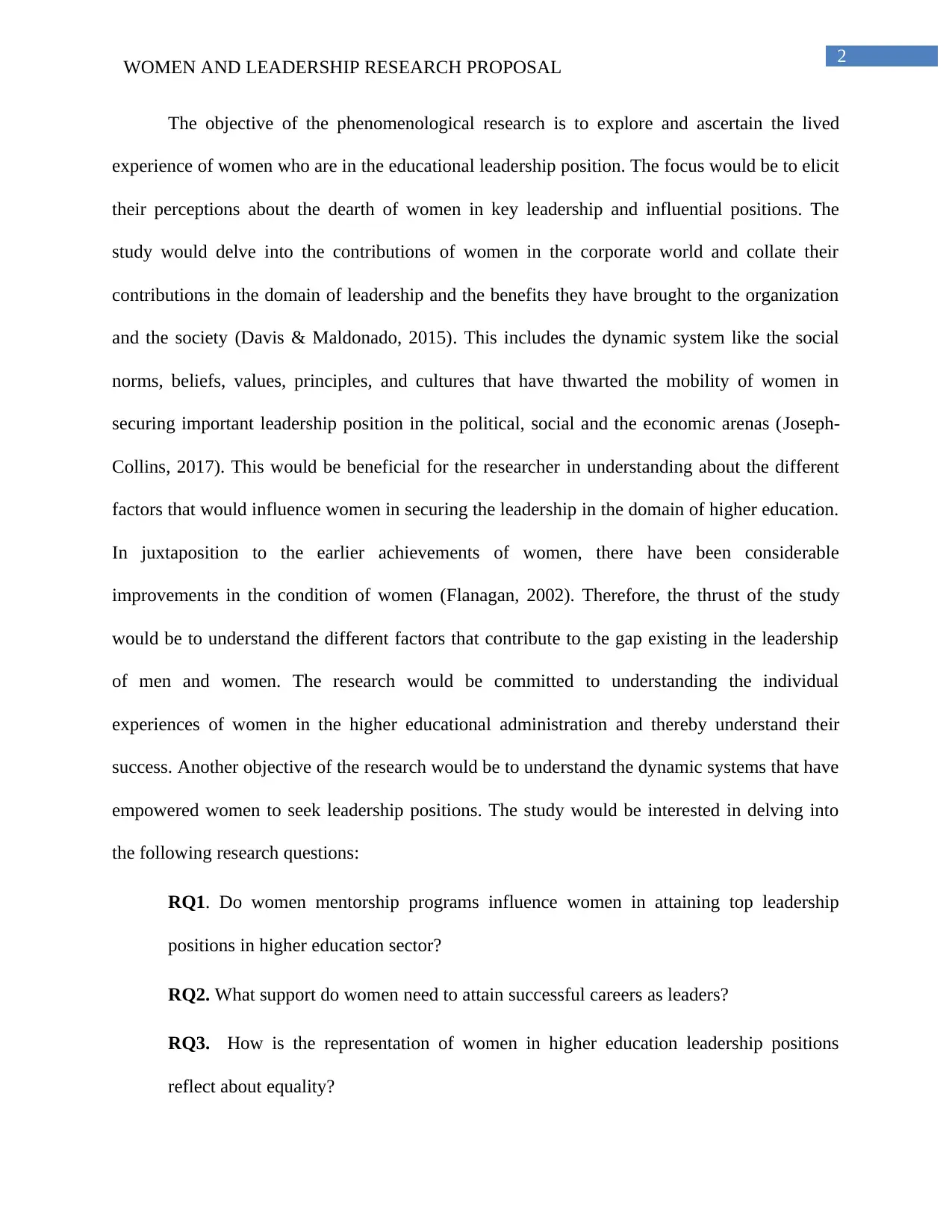
2
WOMEN AND LEADERSHIP RESEARCH PROPOSAL
The objective of the phenomenological research is to explore and ascertain the lived
experience of women who are in the educational leadership position. The focus would be to elicit
their perceptions about the dearth of women in key leadership and influential positions. The
study would delve into the contributions of women in the corporate world and collate their
contributions in the domain of leadership and the benefits they have brought to the organization
and the society (Davis & Maldonado, 2015). This includes the dynamic system like the social
norms, beliefs, values, principles, and cultures that have thwarted the mobility of women in
securing important leadership position in the political, social and the economic arenas (Joseph-
Collins, 2017). This would be beneficial for the researcher in understanding about the different
factors that would influence women in securing the leadership in the domain of higher education.
In juxtaposition to the earlier achievements of women, there have been considerable
improvements in the condition of women (Flanagan, 2002). Therefore, the thrust of the study
would be to understand the different factors that contribute to the gap existing in the leadership
of men and women. The research would be committed to understanding the individual
experiences of women in the higher educational administration and thereby understand their
success. Another objective of the research would be to understand the dynamic systems that have
empowered women to seek leadership positions. The study would be interested in delving into
the following research questions:
RQ1. Do women mentorship programs influence women in attaining top leadership
positions in higher education sector?
RQ2. What support do women need to attain successful careers as leaders?
RQ3. How is the representation of women in higher education leadership positions
reflect about equality?
WOMEN AND LEADERSHIP RESEARCH PROPOSAL
The objective of the phenomenological research is to explore and ascertain the lived
experience of women who are in the educational leadership position. The focus would be to elicit
their perceptions about the dearth of women in key leadership and influential positions. The
study would delve into the contributions of women in the corporate world and collate their
contributions in the domain of leadership and the benefits they have brought to the organization
and the society (Davis & Maldonado, 2015). This includes the dynamic system like the social
norms, beliefs, values, principles, and cultures that have thwarted the mobility of women in
securing important leadership position in the political, social and the economic arenas (Joseph-
Collins, 2017). This would be beneficial for the researcher in understanding about the different
factors that would influence women in securing the leadership in the domain of higher education.
In juxtaposition to the earlier achievements of women, there have been considerable
improvements in the condition of women (Flanagan, 2002). Therefore, the thrust of the study
would be to understand the different factors that contribute to the gap existing in the leadership
of men and women. The research would be committed to understanding the individual
experiences of women in the higher educational administration and thereby understand their
success. Another objective of the research would be to understand the dynamic systems that have
empowered women to seek leadership positions. The study would be interested in delving into
the following research questions:
RQ1. Do women mentorship programs influence women in attaining top leadership
positions in higher education sector?
RQ2. What support do women need to attain successful careers as leaders?
RQ3. How is the representation of women in higher education leadership positions
reflect about equality?
⊘ This is a preview!⊘
Do you want full access?
Subscribe today to unlock all pages.

Trusted by 1+ million students worldwide
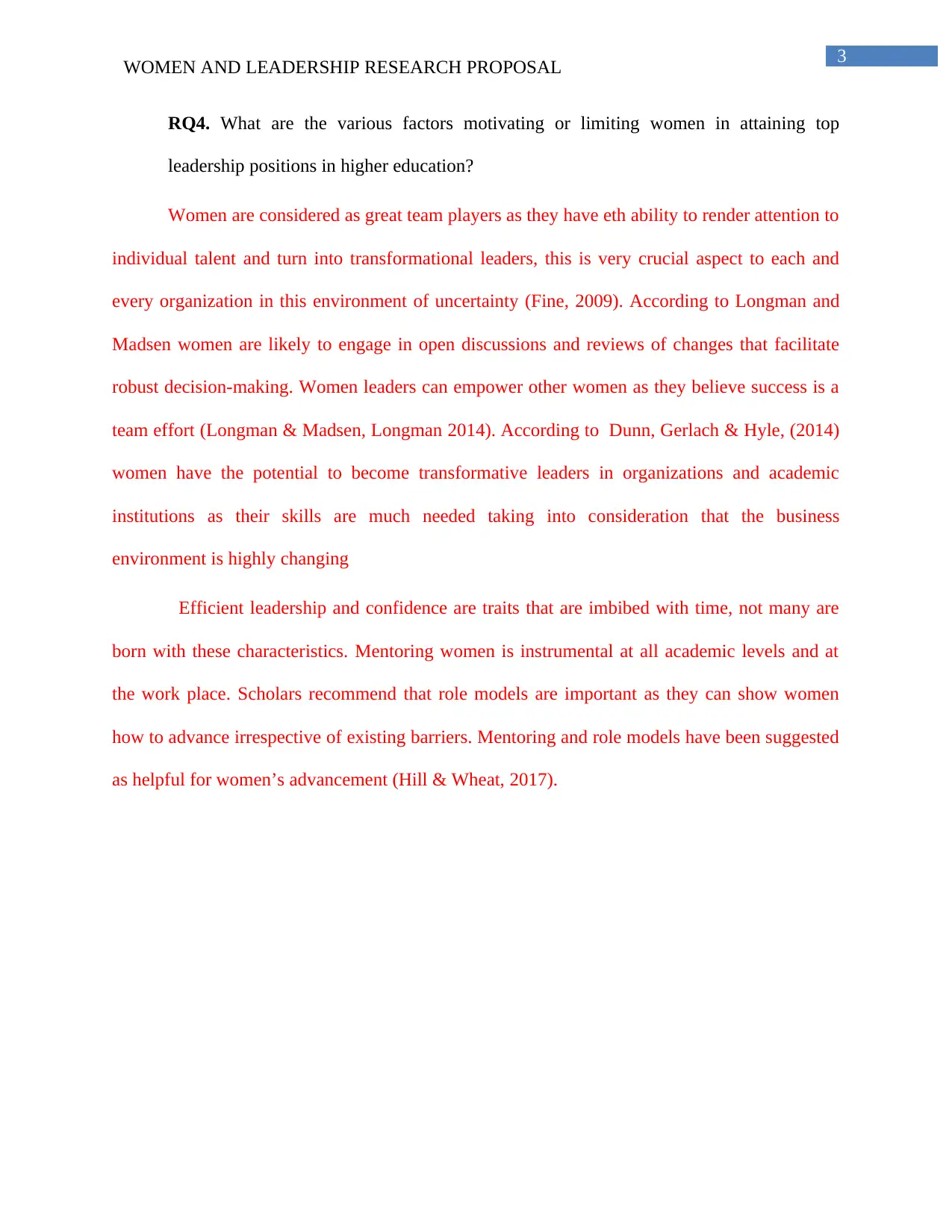
3
WOMEN AND LEADERSHIP RESEARCH PROPOSAL
RQ4. What are the various factors motivating or limiting women in attaining top
leadership positions in higher education?
Women are considered as great team players as they have eth ability to render attention to
individual talent and turn into transformational leaders, this is very crucial aspect to each and
every organization in this environment of uncertainty (Fine, 2009). According to Longman and
Madsen women are likely to engage in open discussions and reviews of changes that facilitate
robust decision-making. Women leaders can empower other women as they believe success is a
team effort (Longman & Madsen, Longman 2014). According to Dunn, Gerlach & Hyle, (2014)
women have the potential to become transformative leaders in organizations and academic
institutions as their skills are much needed taking into consideration that the business
environment is highly changing
Efficient leadership and confidence are traits that are imbibed with time, not many are
born with these characteristics. Mentoring women is instrumental at all academic levels and at
the work place. Scholars recommend that role models are important as they can show women
how to advance irrespective of existing barriers. Mentoring and role models have been suggested
as helpful for women’s advancement (Hill & Wheat, 2017).
WOMEN AND LEADERSHIP RESEARCH PROPOSAL
RQ4. What are the various factors motivating or limiting women in attaining top
leadership positions in higher education?
Women are considered as great team players as they have eth ability to render attention to
individual talent and turn into transformational leaders, this is very crucial aspect to each and
every organization in this environment of uncertainty (Fine, 2009). According to Longman and
Madsen women are likely to engage in open discussions and reviews of changes that facilitate
robust decision-making. Women leaders can empower other women as they believe success is a
team effort (Longman & Madsen, Longman 2014). According to Dunn, Gerlach & Hyle, (2014)
women have the potential to become transformative leaders in organizations and academic
institutions as their skills are much needed taking into consideration that the business
environment is highly changing
Efficient leadership and confidence are traits that are imbibed with time, not many are
born with these characteristics. Mentoring women is instrumental at all academic levels and at
the work place. Scholars recommend that role models are important as they can show women
how to advance irrespective of existing barriers. Mentoring and role models have been suggested
as helpful for women’s advancement (Hill & Wheat, 2017).
Paraphrase This Document
Need a fresh take? Get an instant paraphrase of this document with our AI Paraphraser
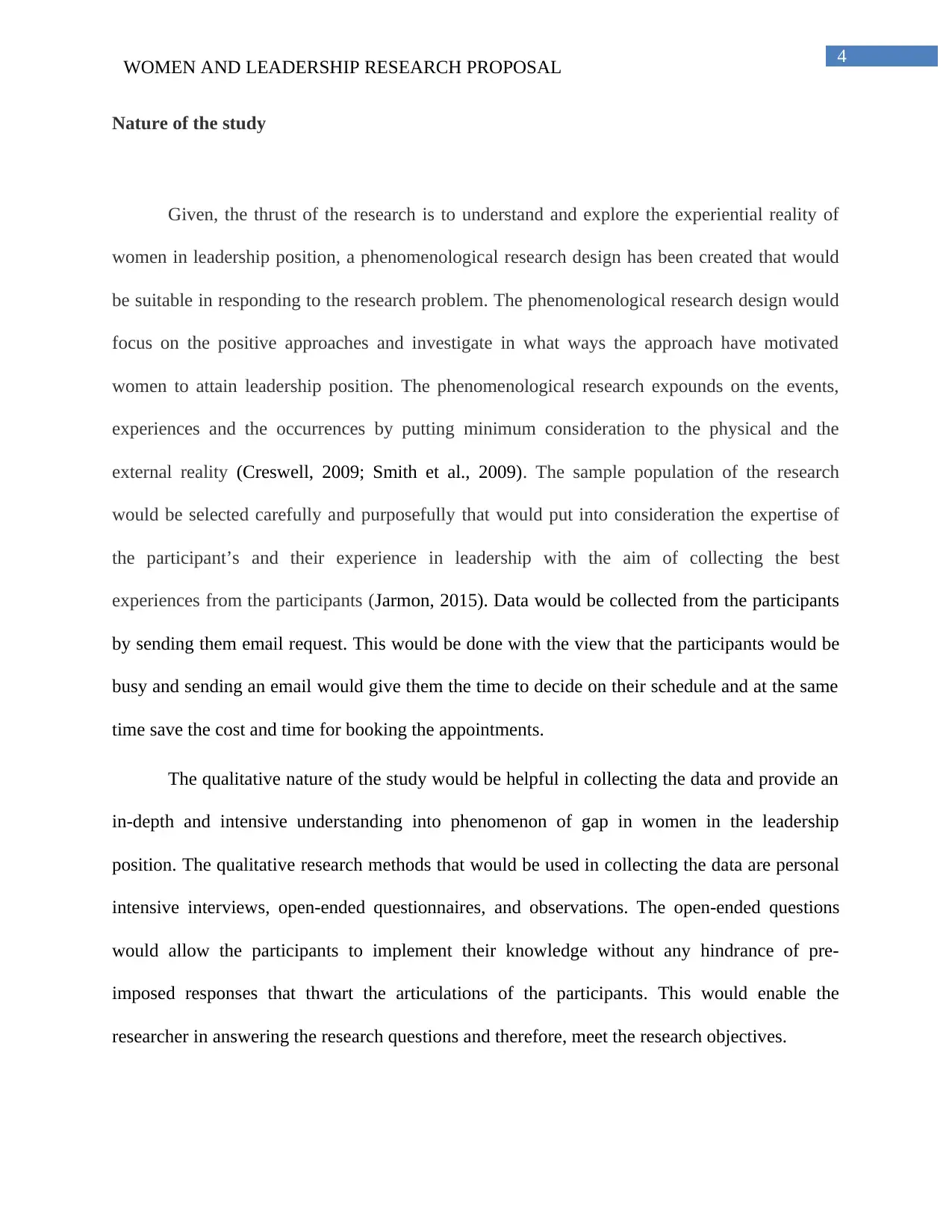
4
WOMEN AND LEADERSHIP RESEARCH PROPOSAL
Nature of the study
Given, the thrust of the research is to understand and explore the experiential reality of
women in leadership position, a phenomenological research design has been created that would
be suitable in responding to the research problem. The phenomenological research design would
focus on the positive approaches and investigate in what ways the approach have motivated
women to attain leadership position. The phenomenological research expounds on the events,
experiences and the occurrences by putting minimum consideration to the physical and the
external reality (Creswell, 2009; Smith et al., 2009). The sample population of the research
would be selected carefully and purposefully that would put into consideration the expertise of
the participant’s and their experience in leadership with the aim of collecting the best
experiences from the participants (Jarmon, 2015). Data would be collected from the participants
by sending them email request. This would be done with the view that the participants would be
busy and sending an email would give them the time to decide on their schedule and at the same
time save the cost and time for booking the appointments.
The qualitative nature of the study would be helpful in collecting the data and provide an
in-depth and intensive understanding into phenomenon of gap in women in the leadership
position. The qualitative research methods that would be used in collecting the data are personal
intensive interviews, open-ended questionnaires, and observations. The open-ended questions
would allow the participants to implement their knowledge without any hindrance of pre-
imposed responses that thwart the articulations of the participants. This would enable the
researcher in answering the research questions and therefore, meet the research objectives.
WOMEN AND LEADERSHIP RESEARCH PROPOSAL
Nature of the study
Given, the thrust of the research is to understand and explore the experiential reality of
women in leadership position, a phenomenological research design has been created that would
be suitable in responding to the research problem. The phenomenological research design would
focus on the positive approaches and investigate in what ways the approach have motivated
women to attain leadership position. The phenomenological research expounds on the events,
experiences and the occurrences by putting minimum consideration to the physical and the
external reality (Creswell, 2009; Smith et al., 2009). The sample population of the research
would be selected carefully and purposefully that would put into consideration the expertise of
the participant’s and their experience in leadership with the aim of collecting the best
experiences from the participants (Jarmon, 2015). Data would be collected from the participants
by sending them email request. This would be done with the view that the participants would be
busy and sending an email would give them the time to decide on their schedule and at the same
time save the cost and time for booking the appointments.
The qualitative nature of the study would be helpful in collecting the data and provide an
in-depth and intensive understanding into phenomenon of gap in women in the leadership
position. The qualitative research methods that would be used in collecting the data are personal
intensive interviews, open-ended questionnaires, and observations. The open-ended questions
would allow the participants to implement their knowledge without any hindrance of pre-
imposed responses that thwart the articulations of the participants. This would enable the
researcher in answering the research questions and therefore, meet the research objectives.
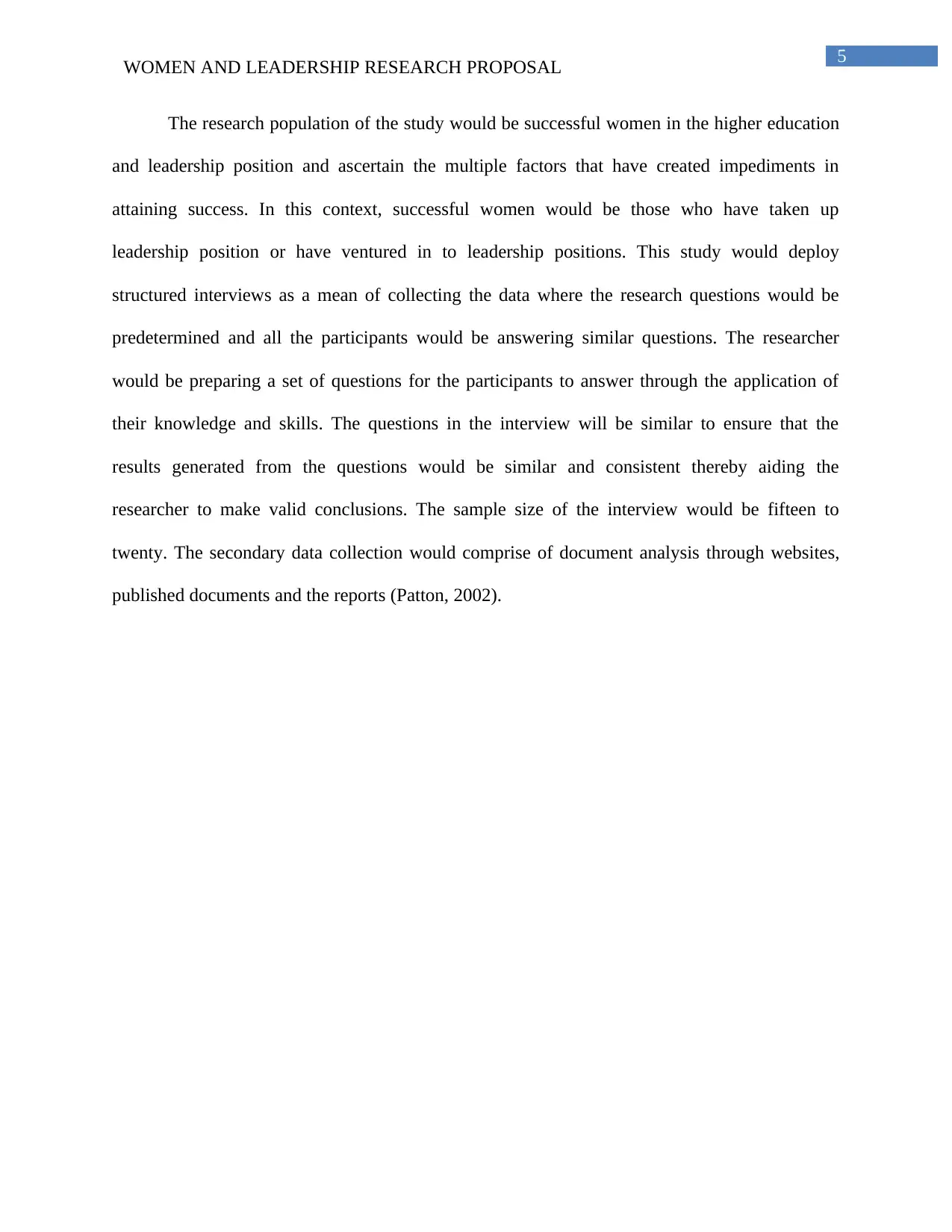
5
WOMEN AND LEADERSHIP RESEARCH PROPOSAL
The research population of the study would be successful women in the higher education
and leadership position and ascertain the multiple factors that have created impediments in
attaining success. In this context, successful women would be those who have taken up
leadership position or have ventured in to leadership positions. This study would deploy
structured interviews as a mean of collecting the data where the research questions would be
predetermined and all the participants would be answering similar questions. The researcher
would be preparing a set of questions for the participants to answer through the application of
their knowledge and skills. The questions in the interview will be similar to ensure that the
results generated from the questions would be similar and consistent thereby aiding the
researcher to make valid conclusions. The sample size of the interview would be fifteen to
twenty. The secondary data collection would comprise of document analysis through websites,
published documents and the reports (Patton, 2002).
WOMEN AND LEADERSHIP RESEARCH PROPOSAL
The research population of the study would be successful women in the higher education
and leadership position and ascertain the multiple factors that have created impediments in
attaining success. In this context, successful women would be those who have taken up
leadership position or have ventured in to leadership positions. This study would deploy
structured interviews as a mean of collecting the data where the research questions would be
predetermined and all the participants would be answering similar questions. The researcher
would be preparing a set of questions for the participants to answer through the application of
their knowledge and skills. The questions in the interview will be similar to ensure that the
results generated from the questions would be similar and consistent thereby aiding the
researcher to make valid conclusions. The sample size of the interview would be fifteen to
twenty. The secondary data collection would comprise of document analysis through websites,
published documents and the reports (Patton, 2002).
⊘ This is a preview!⊘
Do you want full access?
Subscribe today to unlock all pages.

Trusted by 1+ million students worldwide
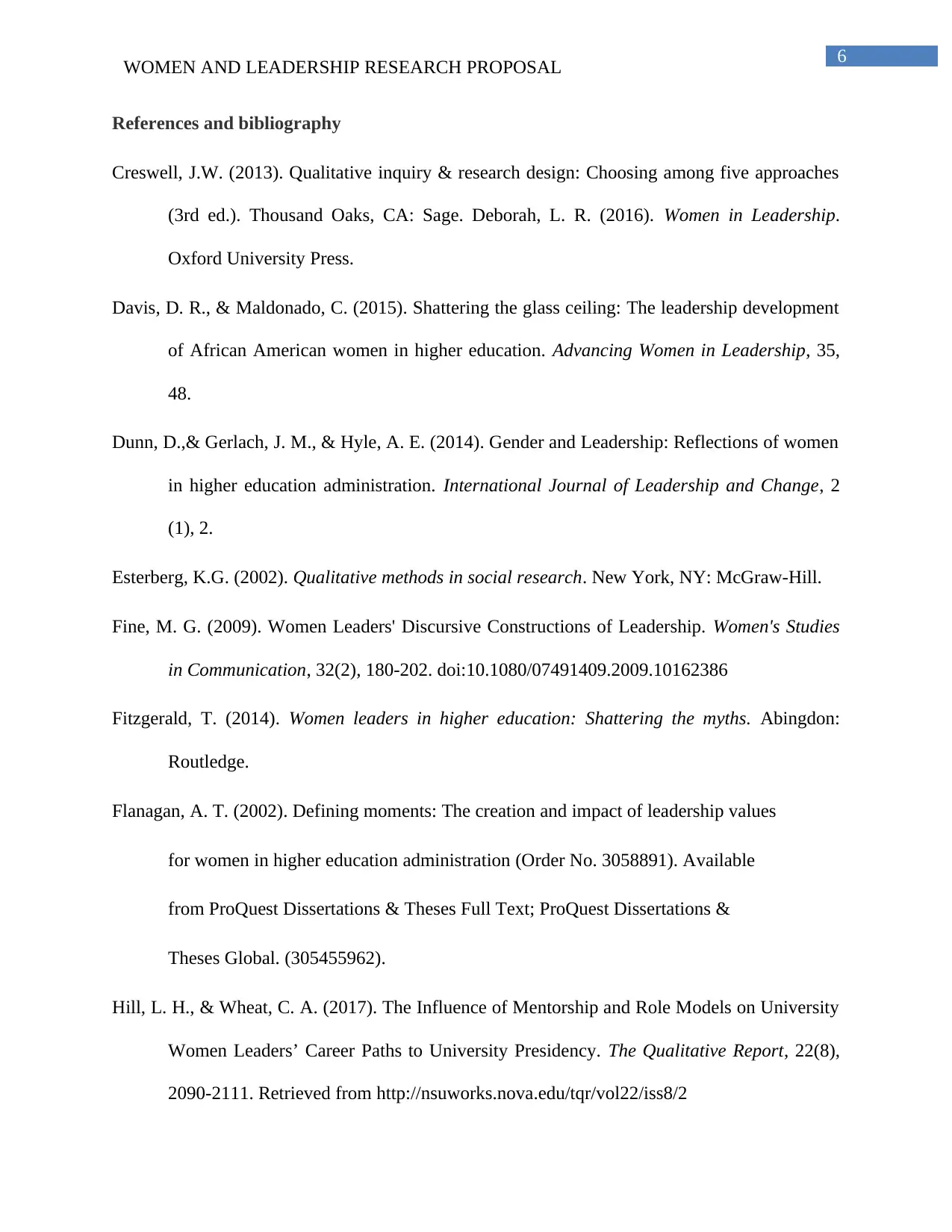
6
WOMEN AND LEADERSHIP RESEARCH PROPOSAL
References and bibliography
Creswell, J.W. (2013). Qualitative inquiry & research design: Choosing among five approaches
(3rd ed.). Thousand Oaks, CA: Sage. Deborah, L. R. (2016). Women in Leadership.
Oxford University Press.
Davis, D. R., & Maldonado, C. (2015). Shattering the glass ceiling: The leadership development
of African American women in higher education. Advancing Women in Leadership, 35,
48.
Dunn, D.,& Gerlach, J. M., & Hyle, A. E. (2014). Gender and Leadership: Reflections of women
in higher education administration. International Journal of Leadership and Change, 2
(1), 2.
Esterberg, K.G. (2002). Qualitative methods in social research. New York, NY: McGraw-Hill.
Fine, M. G. (2009). Women Leaders' Discursive Constructions of Leadership. Women's Studies
in Communication, 32(2), 180-202. doi:10.1080/07491409.2009.10162386
Fitzgerald, T. (2014). Women leaders in higher education: Shattering the myths. Abingdon:
Routledge.
Flanagan, A. T. (2002). Defining moments: The creation and impact of leadership values
for women in higher education administration (Order No. 3058891). Available
from ProQuest Dissertations & Theses Full Text; ProQuest Dissertations &
Theses Global. (305455962).
Hill, L. H., & Wheat, C. A. (2017). The Influence of Mentorship and Role Models on University
Women Leaders’ Career Paths to University Presidency. The Qualitative Report, 22(8),
2090-2111. Retrieved from http://nsuworks.nova.edu/tqr/vol22/iss8/2
WOMEN AND LEADERSHIP RESEARCH PROPOSAL
References and bibliography
Creswell, J.W. (2013). Qualitative inquiry & research design: Choosing among five approaches
(3rd ed.). Thousand Oaks, CA: Sage. Deborah, L. R. (2016). Women in Leadership.
Oxford University Press.
Davis, D. R., & Maldonado, C. (2015). Shattering the glass ceiling: The leadership development
of African American women in higher education. Advancing Women in Leadership, 35,
48.
Dunn, D.,& Gerlach, J. M., & Hyle, A. E. (2014). Gender and Leadership: Reflections of women
in higher education administration. International Journal of Leadership and Change, 2
(1), 2.
Esterberg, K.G. (2002). Qualitative methods in social research. New York, NY: McGraw-Hill.
Fine, M. G. (2009). Women Leaders' Discursive Constructions of Leadership. Women's Studies
in Communication, 32(2), 180-202. doi:10.1080/07491409.2009.10162386
Fitzgerald, T. (2014). Women leaders in higher education: Shattering the myths. Abingdon:
Routledge.
Flanagan, A. T. (2002). Defining moments: The creation and impact of leadership values
for women in higher education administration (Order No. 3058891). Available
from ProQuest Dissertations & Theses Full Text; ProQuest Dissertations &
Theses Global. (305455962).
Hill, L. H., & Wheat, C. A. (2017). The Influence of Mentorship and Role Models on University
Women Leaders’ Career Paths to University Presidency. The Qualitative Report, 22(8),
2090-2111. Retrieved from http://nsuworks.nova.edu/tqr/vol22/iss8/2
Paraphrase This Document
Need a fresh take? Get an instant paraphrase of this document with our AI Paraphraser
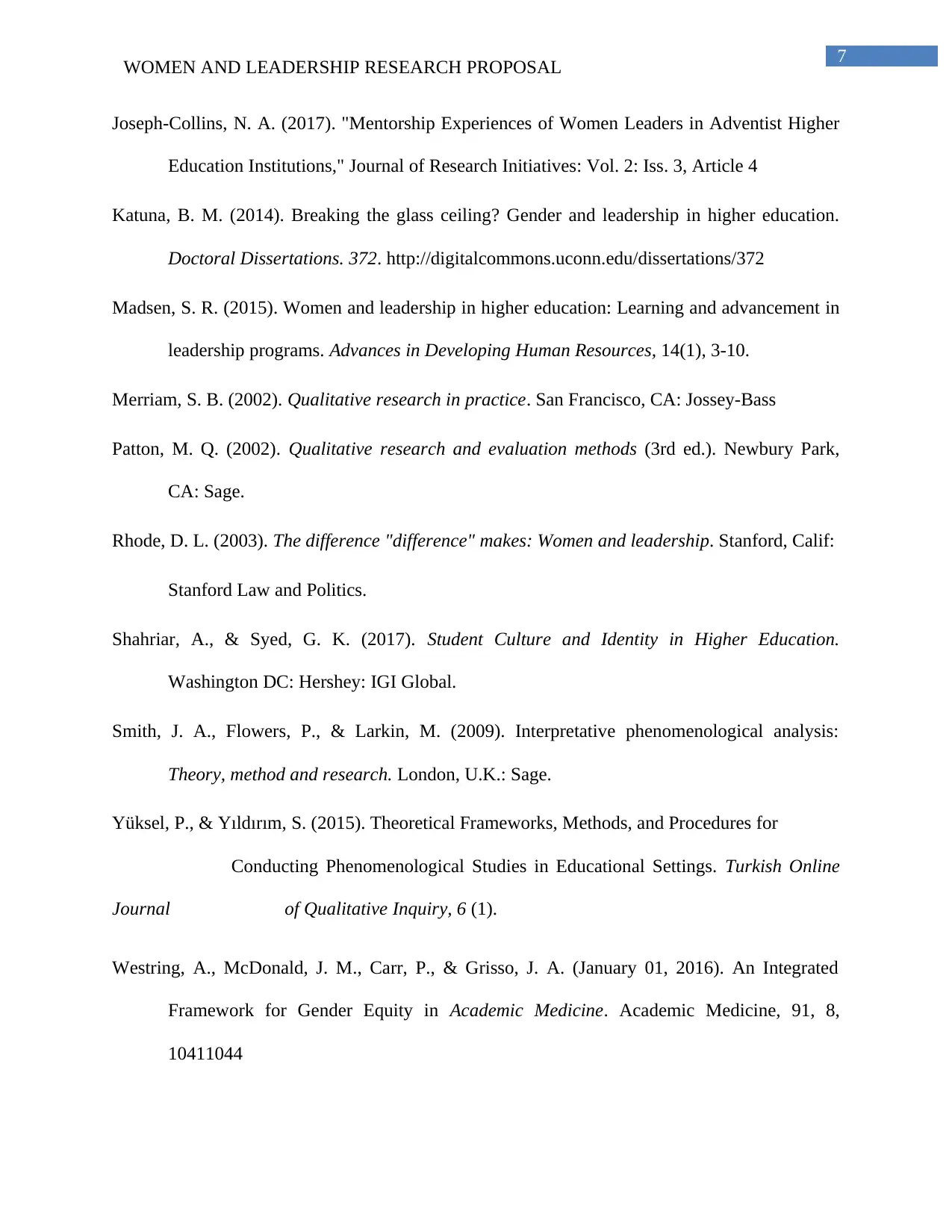
7
WOMEN AND LEADERSHIP RESEARCH PROPOSAL
Joseph-Collins, N. A. (2017). "Mentorship Experiences of Women Leaders in Adventist Higher
Education Institutions," Journal of Research Initiatives: Vol. 2: Iss. 3, Article 4
Katuna, B. M. (2014). Breaking the glass ceiling? Gender and leadership in higher education.
Doctoral Dissertations. 372. http://digitalcommons.uconn.edu/dissertations/372
Madsen, S. R. (2015). Women and leadership in higher education: Learning and advancement in
leadership programs. Advances in Developing Human Resources, 14(1), 3-10.
Merriam, S. B. (2002). Qualitative research in practice. San Francisco, CA: Jossey-Bass
Patton, M. Q. (2002). Qualitative research and evaluation methods (3rd ed.). Newbury Park,
CA: Sage.
Rhode, D. L. (2003). The difference "difference" makes: Women and leadership. Stanford, Calif:
Stanford Law and Politics.
Shahriar, A., & Syed, G. K. (2017). Student Culture and Identity in Higher Education.
Washington DC: Hershey: IGI Global.
Smith, J. A., Flowers, P., & Larkin, M. (2009). Interpretative phenomenological analysis:
Theory, method and research. London, U.K.: Sage.
Yüksel, P., & Yıldırım, S. (2015). Theoretical Frameworks, Methods, and Procedures for
Conducting Phenomenological Studies in Educational Settings. Turkish Online
Journal of Qualitative Inquiry, 6 (1).
Westring, A., McDonald, J. M., Carr, P., & Grisso, J. A. (January 01, 2016). An Integrated
Framework for Gender Equity in Academic Medicine. Academic Medicine, 91, 8,
10411044
WOMEN AND LEADERSHIP RESEARCH PROPOSAL
Joseph-Collins, N. A. (2017). "Mentorship Experiences of Women Leaders in Adventist Higher
Education Institutions," Journal of Research Initiatives: Vol. 2: Iss. 3, Article 4
Katuna, B. M. (2014). Breaking the glass ceiling? Gender and leadership in higher education.
Doctoral Dissertations. 372. http://digitalcommons.uconn.edu/dissertations/372
Madsen, S. R. (2015). Women and leadership in higher education: Learning and advancement in
leadership programs. Advances in Developing Human Resources, 14(1), 3-10.
Merriam, S. B. (2002). Qualitative research in practice. San Francisco, CA: Jossey-Bass
Patton, M. Q. (2002). Qualitative research and evaluation methods (3rd ed.). Newbury Park,
CA: Sage.
Rhode, D. L. (2003). The difference "difference" makes: Women and leadership. Stanford, Calif:
Stanford Law and Politics.
Shahriar, A., & Syed, G. K. (2017). Student Culture and Identity in Higher Education.
Washington DC: Hershey: IGI Global.
Smith, J. A., Flowers, P., & Larkin, M. (2009). Interpretative phenomenological analysis:
Theory, method and research. London, U.K.: Sage.
Yüksel, P., & Yıldırım, S. (2015). Theoretical Frameworks, Methods, and Procedures for
Conducting Phenomenological Studies in Educational Settings. Turkish Online
Journal of Qualitative Inquiry, 6 (1).
Westring, A., McDonald, J. M., Carr, P., & Grisso, J. A. (January 01, 2016). An Integrated
Framework for Gender Equity in Academic Medicine. Academic Medicine, 91, 8,
10411044
1 out of 8
Your All-in-One AI-Powered Toolkit for Academic Success.
+13062052269
info@desklib.com
Available 24*7 on WhatsApp / Email
![[object Object]](/_next/static/media/star-bottom.7253800d.svg)
Unlock your academic potential
Copyright © 2020–2025 A2Z Services. All Rights Reserved. Developed and managed by ZUCOL.
